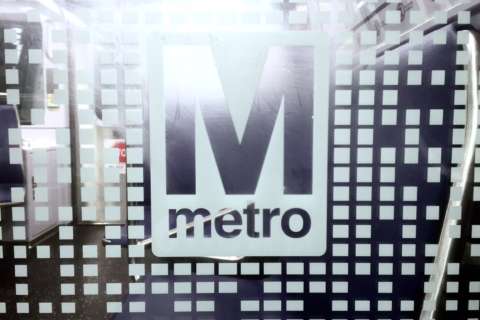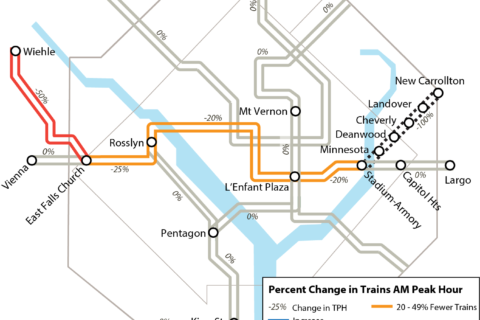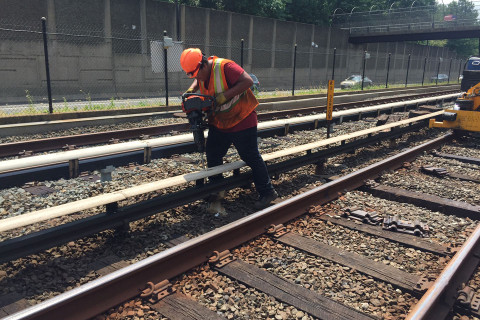WASHINGTON — Metro will shut down all five Orange Lines east of Stadium-Armory next week for a month-long work zone and a board member is concerned the transit agency hasn’t done enough to let riders know about what’s ahead.
“Obviously in this instance it was Prince George’s County, but I do think more generally that WMATA has not done a good job of communicating what they’re doing, why they’re doing it, to the public at large — in particular this one. This is a very difficult situation for the people of Prince George’s County who live on the Orange Line,” said board member Malcom Augustine, of Prince George’s County, Thursday.
The track work shuts down all three Maryland Orange Line stations — New Carrollton, Landover and Cheverly — as well as D.C.’s two Orange Line stations east of the Anacostia River — Minnesota Avenue and Deanwood — from May 16 to June 15.
Metro had initially announced the added work zone would be a very long single-tracking zone, but announced two weeks ago that there would instead be a complete shutdown of the tracks. Augustine believes there should have been more warning of the change, since that could have provided more time to figure out other options.
“We understood there was going to be a surge; people can plan for that. They know if they’re going to single-track, then you work your way around it. But that’s completely different than [to] shut down completely, and … that decision, I believe, was made fairly late,” Augustine said.
Metro General Manager Paul Wiedefeld said the change was due to lessons learned from other work zones, and a better understanding of the true depth of the problems on that stretch of tracks.
“Part of it was what we were up against, what we had to do, and then also when we started to look at the impacts it had on the entire system versus a much smaller part of the system,” Wiedefeld said.
He acknowledged Metro’s communication could always be better.
Goodwill
Augustine, who lives near the Cheverly station, said he has had to personally explain the alternative options to some riders this week because Metro handouts do not explain all of the detailed shuttle bus plans.
“It’s just not really a good way to build on goodwill,” Augustine said. “We’ve known that … we can get much more work done when we shut down stations … and I understand why we would do that, but what I can’t understand is why we wouldn’t communicate that much earlier, give people a lot more time to think about it, and then also to just give them better options.”
Wiedefeld doesn’t think earlier notice would have changed many riders’ plans.
“What we have experienced over time is, people focus on this literally when it starts. I mean, it’s just human nature, I think,” Wiedefeld said.
In past work zones, the first few days have seen some problems or confusion until more riders settle into a new routine, either on Metro or some other mode of transportation. Riders have also raised concerns about communication during work zones about changes, which track trains were arriving on, or which buses they were supposed to use.
Alternatives
Shuttle buses will add significant time to riders’ trips in this work zone, but Wiedefeld shied away Thursday from directly telling riders to find another way of getting around. Before ridership declines accelerated last year, he had regularly warned riders away at news conferences Metro held for previous surges.
“If they’re willing to put up with some of that stuff, or they have to in some cases, they will use the service,” Wiedefeld said.
Metro hopes many riders who typically drive to Orange Line stations will instead park at Blue, Green or Red Line stations. MARC trains at New Carrollton, Bowie State or other stations are viable alternatives too, and Augustine said MARC may add extra cars to some trains if needed. MARC riders who typically transfer to Metro at New Carrollton to reach the District should instead remain on the Penn Line to Union Station.
Regular bus routes connect the Orange Line stations to other Metro lines as well, and there will be limited shuttle buses between the closed Orange Line stations and nearby Blue Line stations in addition to limited regular shuttle bus service. In all cases, Metro wants riders to tap their SmarTrip cards when boarding a shuttle bus, so that riders can be charged the same rate as a usual trip.
“Clearly, people are going to have to make some adjustments,” Augustine said. “This is going to have a long-lasting effect. My neighbors are talking to me … they’ve already had to make adjustments for how they’re going to have to get to and from work for a month and my concern is, of course, that they don’t come back.”







